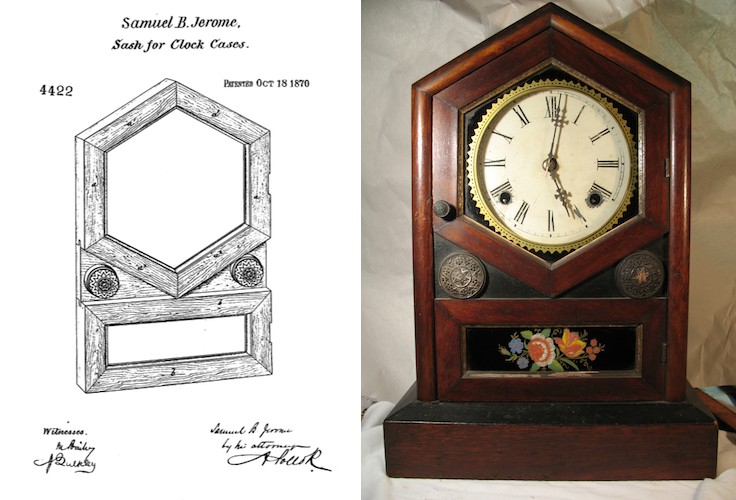On left, drawing for Patent 1,200, issued to Noble Jerome June 27, 1839. On right, one of the earliest versions (type 1.113) of this movement. This particular movement is from a C&N Jerome short roundside. The only differences between this movement and the version submitted with the patent application are cosmetic: all gears in the patent example are solid brass, whereas the escape wheel and #1 strike wheel are spoked in my movement. It is not known how many of these early solid gear movements were made. Fourteen have been documented to date [Watch & Clock Bull. 403 (May/June 2013), p. 323-324]. Versions containing all spoked gears (type 1.114) dating to 1838 were rapidly introduced, so production of types 1.111-1.113 likely spanned months at most.
On left, the only patent issued to Chauncey Jerome, Design patent 883 (April 14, 1857). On right, a 30-hr spring-driven example made by the Waterbury Clock Co., likely when Chauncey Jerome was supervising case making for the company. This case style was also used with 30-hr (see the New Haven Clock Co. example) and 8-day weight-driven clocks.
On left, Design patent 959, issued to Samuel Bryan Jerome on October 20, 1857. On right, an example made by the Waterbury Clock Co. For more on the clock, click here. An 8-day weight-driven version, also by the Waterbury Clock Co., can be seen here. Witnesses to his patent were Frances C. Jerome (Samuel’s wife, maiden name Colt) and Sara A. Colt, who I assume was related to Frances (sister, perhaps?). This patent was Samuel’s first, and I believe it was the only one witnessed by family.
On left, Design patent 2057, issued to S.B. Jerome on May 9, 1865. On right, a Jerome & Co. Octagon clock made by S.B. Jerome. The patent describes several elements: 1) the octagonal form of the case; 2) a covering on the case consisting of leather or cloth with the appearance of leather; 3) a gilt ornamental moulding around the edge; and 4) a button or oval bead at the corners. It’s not clear whether the octagonal form is integral to the patent or not; certainly other makers used the octagonal form. This particular octagon clock utilizes two of the distinguishing elements of the patent: the faux leather cover and the buttons.
On left, Design patent 4422, issued to Samuel B. Jerome on October 18, 1870. On right, a Jerome & Co. clock (S.B. Jerome principal partner).
This was a recent find while searching patents on the internet that has nothing to do with clocks but everything to do with Chauncey Jerome. I ran across a reference to a Chauncey Jerome patent in the March 12, 1870 edition of Scientific American. Patent number 100,296 was issued on March 1, 1870 to Chauncey Jerome for an improved cigar box. By this point, Chauncey was deceased (d. April 20, 1868). The patent was therefore assigned to Samuel B. Jerome (Chauncey’s son and executor of his estate), who in term assigned it to Richard A. Douglas (if I understand the assignments correctly). The essence of his invention was the use of interior and exterior veneers of Spanish cedar encasing a box made of common wood (pine or spruce, perhaps). Contemporary cigar boxes made of solid cedar boards were not very durable, because the cedar was cut thin to reduce costs. By constructing the box of common wood with cedar veneer, the components of the box could be made thicker, thereby resulting in a stronger box.





